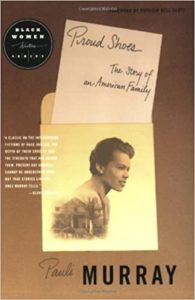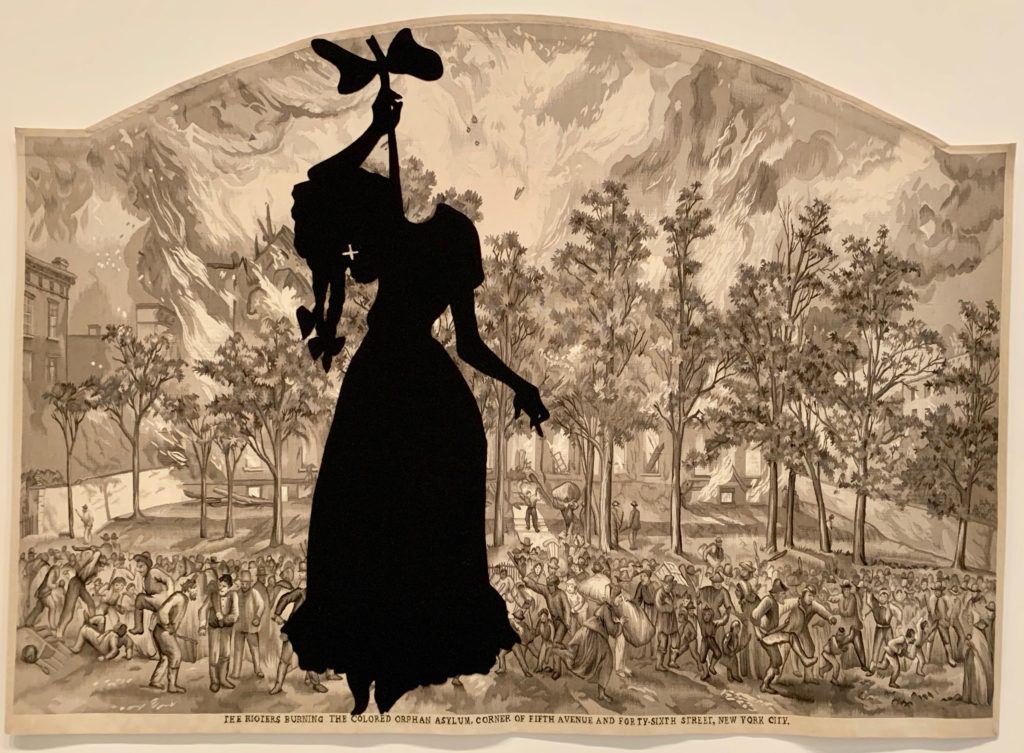Proud Shoes
 Proud Shoes is the first book I’ve read that presents the Civil War and its aftermath from the viewpoint of a free Black man who was an active participant. Robert Fitzgerald, the grandfather of author Pauli Murray, fought for the Union, then participated in Reconstruction by teaching recently freed slaves. Having read biographies of Ulysses Grant and Frederic Douglass last summer, I knew that the war was bloody and “reconstruction” was a mess, but it was hard to imagine how it felt to live through this tumultuous period. Douglass, the foremost Black leader, didn’t experience the war or reconstruction as directly as Fitzgerald did. Substantiating her grandfather’s diary and family stories with impressive research, Pauli Murray‘s vivid biography of her grandparents is a valuable contribution to American history. First published in 1956, it was largely ignored until being re-issued in 1978, 1984, and 1999. From my frequent quotes below, you can see the high quality of Murray’s writing and her unique insights.
Proud Shoes is the first book I’ve read that presents the Civil War and its aftermath from the viewpoint of a free Black man who was an active participant. Robert Fitzgerald, the grandfather of author Pauli Murray, fought for the Union, then participated in Reconstruction by teaching recently freed slaves. Having read biographies of Ulysses Grant and Frederic Douglass last summer, I knew that the war was bloody and “reconstruction” was a mess, but it was hard to imagine how it felt to live through this tumultuous period. Douglass, the foremost Black leader, didn’t experience the war or reconstruction as directly as Fitzgerald did. Substantiating her grandfather’s diary and family stories with impressive research, Pauli Murray‘s vivid biography of her grandparents is a valuable contribution to American history. First published in 1956, it was largely ignored until being re-issued in 1978, 1984, and 1999. From my frequent quotes below, you can see the high quality of Murray’s writing and her unique insights.
If Grandfather had not volunteered for the Union in 1863 and come south three years later as a missionary among the Negro freedmen, our family might not have walked in such proud shoes and felt so assured of its place in history. We might have fought our battles with poverty and color troubles, thinking of ourselves as nobodies or not thinking of ourselves at all, dying out with nothing to remember of us except a few census figures. What he attempted–far more than what he finally achieved–made him our colossus and beacon light. Because of him we felt that we belonged, that we had a stake in our country’s future, and we clung to that no matter how often it was snatched away from us. (page 24)
Robert Fitzgerald first sought to join the Union Army in 1861, but Negroes were not accepted at first, so he joined the Quartermasters. This group was not yet part of the Army’s structure, just a loose collection of young men who drove wagons, delivered horses, and wangled supplies.
In his wanderings about Maryland and Virginia with the teamsters, he saw that there were not two but three armies in the field. The Union had chosen to fight in southern territory among four million slaves intensely interested in the outcome of the contest. One out of every three persons in the South was a slave; these people knew their fate hung in the balance. A sprawling army of blacks materialized when Union and Confederate lines made contact. (page 125)
It was dangerous work that often put him under fire. Fitzgerald was hit by a bullet that lodged behind one eye and gave him problems the rest of his life. Nevertheless, seeking greater involvement, he and his cousin went to Philadelphia and joined the crew of the steamer Continental. Unlike the War Department, which was accepting Negro enlistees by summer 1863, but paying them much less than whites, the Navy had a common-sense plan.
Escaped fugitives and free Negroes served on board the United States vessels without segregation or difference in pay. Farmers and laborers were converted into powder boys and gunners, and before the war ended nearly thirty thousand black men more navy middies and supplied one-fourth of all enlistments.
Fitzgerald had achieved his dream; by the end of July 1863 he was officially in the war. But he still had to learn to deal with the prejudice and racial tension sparked by draft riots in New York two weeks earlier. A Negro orphanage was burned down by men who resented being drafted into a “nigger’s war.” That event was the subject of an arresting artwork I saw at the Norton Museum in March:

Riots spread to Boston and other cities; hundreds of terrified Negroes were left homeless and without food. Fitzgerald had no time to brood over violence against colored people; he was rushed through training and assigned to a ship headed for New Orleans to join the Western Gulf Blockade. There was little action, much drudgery, unbearable heat, and illness among the men. He soon contracted bone fever and malaria.
Grandfather’s brief, inglorious career in the navy ended after four months with the verdict of blindness from his earlier battle wound. His ship proceeded slowly, supplying the Mobile Bay fleet with provisions and battling heavy gales, with a leak that drew ten inches of water. Fitzgerald sat out the trip in a frenzy of frustration, unable to see the one bit of action which enlivened the voyage when his ship chased and seized a British vessel bound for a Rebel port. He could only hear the scurrying sounds, the guns going off and fragments of the story from other men.
At the Chelsea Naval Hospital in Boston, the bone fever subsided after several weeks and his vision partially returned, but doctors told him that his days of active service were over. On January 14, 1864, he was discharged from the Navy, but this stubborn young man was by no means through with the war. The very next day he volunteered as a private in the 5th Massachusetts Cavalry, Company F, and was sent to Camp Meigs in Readville, Massachusetts. “That he was accepted at all was possible only because of the notoriously lax methods of medical examination given to Civil War recruits, especially in those final desperate months of the conflict. Grandfather proudly signed his name to the oath of allegiance to the United State at the bottom of his enlistment papers. That same day he began to keep a diary.” (page 136)
His diary provided his granddaughter a valuable original source. His diary entries showed that Fitzgerald was obsessed by proving his manhood in battle, a goal shared by the men in his regiment. When Captain Charles P. Bowditch, commander of Company F, discovered that Private Fitzgerald had some education, he appointed him company clerk.
Record keeping had been part of his Quaker training and he was meticulous in his work. His eyesight was none too reliable but he bent close to the pages to keep the lines straight….Company F’s muster roll, which he recorded, was typical of the Union’s nearly 200,000 Negro soldiers. Its 83 enlisted men came from seventeen states, Canada, the West Indies and France. In other companies, some even came from Africa. Over half of the enlistees were born in slave states and had come to Massachusetts in order to enlist….By early May, after only two months in camp (the normal two-year period required to train both horse and rider for the cavalry was cut short), they were ordered to report to Washington for active duty. (page 139)
In June 1864, his company fought in Petersburg Virginia, proving the value of even poorly trained Negro soldiers. “While that battle achieved very little in the way of military distinction, its brief though confused show of courage that morning was enough to give Robert Fitzgerald a pride which would be felt throughout his family for the next century.” (page 155)
From the diary and interviews with her aunts and cousins, Murray recounts her grandfather’s challenges and successes teaching those recently freed in North Carolina after the war. She makes clear that our young nation lacked a comprehensive plan for achieving true reconciliation. The “forty acres and a mule” that General Sherman promised never came to fruition. Focus groups and federal aid were as yet unimagined.
Liberty had come at the point of the sword, but to maintain it a whole region must be redeemed. New bridges of communication must be built between the white and black, too big a job to be done with hate, yet the war had left little among the defeated Rebels but piled-up hate. White men were determined that black men give them the same unquestioned obedience they had exacted before the war; black men were equally determined to be treated just like white men. (page 170)
In 1866, Fitzgerald moved from Chester County, Pennsylvania to Chapel Hill, North Carolina to establish schools for freed Blacks. A gifted teacher, he quickly attracted eager learners. By 1869, he had met and married Cornelia Smith, the daughter of an enslaved mother and a white father, who lived in Chapel Hill. The grandparents of my friend Judy Haverkamp, who lent me this book, are buried in Maplewood Cemetery in Durham, which shared a fence with the farm where Pauli Murray’s grandparents raised her. Maplewood Cemetery was for whites only at that time.
Murray, whose grandparents were both descended from “whites,” describes the fluidity of color:
People traveled back and forth through this corridor of mixed bloods as they chose, depending upon their appearance and the strength of their ties. In the border states race lines were so blurred that often pure-blooded white were kidnaped and sold south into slavery as mulattoes. The free colored population was a transmission belt, constantly receiving mixed blood through the emancipation of mulattoes, quadroons and octoroons by their conscience-stricken white kinsfolk and constantly feeding the white mainstream by fair-skinned colored people simply disappearing from the colored race and emerging as whites. (page 66)
The hierarchy of skin color has always been a mystery to me. Growing up in the Panhandle of Texas I saw only a few Black people; I hesitated to classify myself as “white,” since my skin looked pinkish beige to me. And how could I be “Caucasian”? I had no ancestors who came from those mountains in Russia! In Houston, where I attended Rice, I noticed myriad shades of black; but when I worked in Cambridge, 1966-68, I saw very few. In Washington DC, Blacks were the majority; lighter-skinned Blacks seemed to have relatively better jobs. My Self-examination last summer woke me up. Now I try to disregard color and get to know human beings.
There’s so much more to learn in this book. Murray’s grandmother, Cornelia Smith Fitzgerald, took great pride in her Chapel Hill upbringing and the 100 acres her white father/owner left her when he died. She was a significant influence on Pauli, whose mother died when she was three. Pauli Murray grew up to fill the Proud Shoes her grandfather left her. She was an American civil rights activist who became a lawyer, women’s rights activist, Episcopal priest, and author. In 1950, Murray published States’ Laws on Race and Color, an examination and critique of state segregation laws throughout the nation. Thurgood Marshall called Murray’s book the “bible” of the civil rights movement. Drawn to the ministry in 1977, Murray was the first African-American woman to be ordained as an Episcopal priest, in the first year that any women were ordained by that church.
Pauli Murray was only two years younger than Dorothy Height. Thinking of their overlapping interests, I wondered if they had ever worked together. Sure enough, this post by WHYY radio station in Philadelphia links them as “invisible women of the civil rights movement.”
Leave a Reply